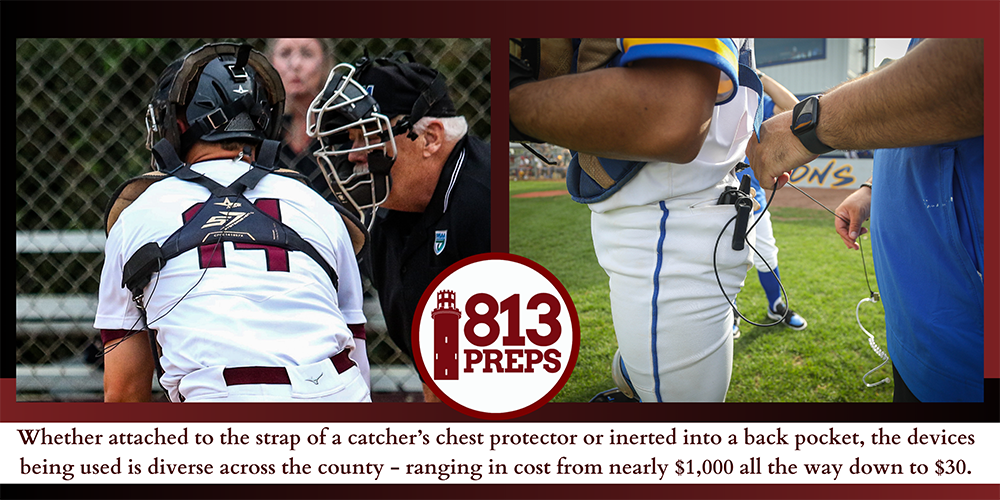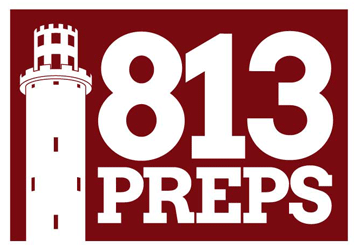Coach-to-catcher communication devices hit area fields
Jefferson senior catcher CJ Padilla fits in the communications earpiece prior to Saturday’s game against Plant.
By Brandon Wright, Features Writer
TAMPA – A decade or so ago the EvoShield shin and elbow guards became vogue in high school baseball, no doubt inspired by MLB stars who donned the equipment. That eventually progressed to the wrap-around shades, which oftentime remained on players’ hats even when the sun was long set. Fast forward to the omnipresent oven mitts that poke out of most kids’ back pockets these days from high school all the way down to 8U travel ball.
MLB has a way of trickling trends down.
“I think the guys call it drip,” Jesuit coach Miguel Menedez said with a chuckle.
And while the newest trend might not be as aesthetically pleasing as the above-mentioned accessories, it’s quickly gaining quite the following.
Seffner Christian head coach Sal Giardina calls in a pitch during a game last week.
Many county teams are now using a communication device to directly relay information via voice from the coaches to catchers. The devices were first approved for use in 2022 at the Major League level and subsequently prior to this season nationally for high school baseball.
Good luck now Astros.
“Stealing signs has always been a part of the game,” Menedez, who sat on the state advisory board that approved the device, said. “Now you really eliminate that. I’m not sure nationally, but no one I know of in the state was against (implementing the device).”
Catchers across the County now have the ability to hear what pitches their coach wants and any pertinent information, supplanting the need for relayed signals from the dugout through touches to the ear, chin and nose.
“It’s just super easy to communicate with my coach,” Armwood catcher Christian Villanueva said. “Now he can tell me exactly what he wants. I think it’s great.”

While there are many different brands, essentially catchers have a wired or wireless earpiece underneath their helmets. Coaches in the dugout speak into a walkie talkie-like device to communicate to said catcher.
Maybe it has something to do with the younger generation that grew up with AirPods, but Villanueva said the earpiece feels natural.
“I don’t even feel it,” he said. “Even when I throw my helmet to get a pop fly it just stays in place.”
And while the devices can range vastly in terms of price and quality, the end game remains the same – make communication smoother.
“I think it’s at least limited a couple mound visits,” Sickles assistant coach Chris Perez said. “It keeps them on the same page because a coach has a direct line right to the catcher. A coach can now coach a catcher, who is the most important guy on defense.”
Sickles head coach Eric Luksis reviews his scouting chart and calls in a pitch to his catcher.
The only real caveat at this time is that communication is one way. Catchers do not have the option to speak back to the coaches.
“We can guide the catchers,” Menedez said. “But you also don’t want to give them too much. They still have to play the game and too much talking can be a bad thing.”
Some of the top-end models can reach nearly $1,000 but with that being out of the range of most high school budgets, the more expensive ones in the County appear to be in the $400 range.
Ranging from wrap-around headsets to a more traditional walkie-talkie style, a diverse collection of communication devices have trickled down from the highest levels of baseball to the high school ranks after being approved for use prior to the 2024 season.
But there’s more than one way to throw a breaking ball.
“I think the one we got was a walkie talkie setup for like $29.99 on Amazon,” Armwood coach Shawn Queen said. “It works great. It makes things go quicker and keeps our pitcher in a rhythm.”
Strawberry Crest catcher Toby Highsmith started using the communication device with his summer travel ball team and hit the ground running when the Chargers opened the season last month.
“It took a second to get used to when I first got it,” he said. “Now I don’t think twice about it. I don’t even notice it’s there.”
Menedez said he expects the next iteration to have a communication device in every player’s ear, aiding fielders in both positioning and pitch anticipation. While this is allowed at the pro and collegiate level, national high school rules currently limit it to one-way communication with the catcher.
“I think you’ll see that as the next evolution,” he said.
Plant head coach Dennis Braun calls in a pitch while senior pitcher Mitchell Doane keeps the pitching chart.
Not everyone has made the leap. A handful of coaches are electing to forego the communication device due to financial reasons or their belief in, ‘Why fix what’s not broken?’
“We’re still doing things old school,” Spoto coach Stephan Knight said. “It’s a little bit out of our budget right now. I hope I can get one. I’ve got two freshmen catchers and I’d like to be in their ear.”
Blake coach Herbert Ayers echoed Knight’s sentiment.
“It’s a financial thing,” he said. “I do see benefits in it though. It takes away complicated signs and hiding signs.”
But it appears Pandora’s Box has been opened and it’s just another example of the technological side of the rapidly-changing game of baseball, from the Big Leagues on down. Is the pitch clock next?
Fingers crossed.

















